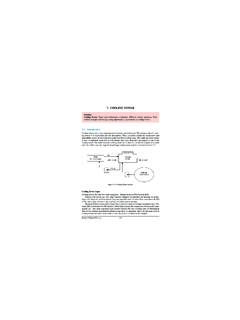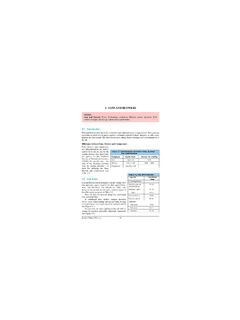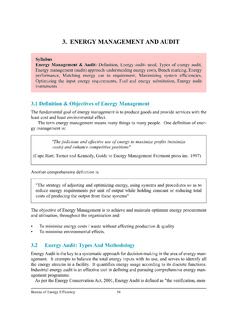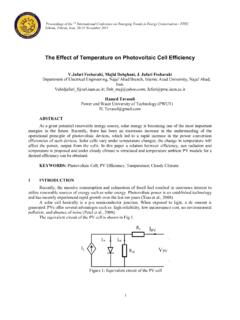Transcription of 12. APPLICATION OF NON-CONVENTIONAL & RENEWABLE …
1 12. APPLICATION OF NON-CONVENTIONAL & RENEWABLE ENERGY SOURCES147 Bureau of Energy Concept of RENEWABLE Energy Renewableenergy sources also called NON-CONVENTIONAL energy, are sources that are continu-ously replenished by natural processes. For example, solar energy, wind energy, bio-energy -bio-fuels grown sustain ably), hydropower etc., are some of the examples of RENEWABLE energysourcesA RENEWABLE energy system converts the energy found in sunlight, wind, falling-water, sea-waves, geothermal heat, or biomass into a form, we can use such as heat or electricity.
2 Most ofthe RENEWABLE energy comes either directly or indirectly from sun and wind and can never beexhausted, and therefore they are called , most of the world's energy sources are derived from conventional sources-fossilfuels such as coal, oil, and natural gases. These fuels are often termed non- RENEWABLE energysources. Although, the available quantity of these fuels are extremely large, they are neverthe-less finite and so will in principle 'run out' at some time in the futureRenewable energy sources are essentially flowsof energy, whereas the fossil and nuclearfuels are, in essence, stocksof energyVarious forms of RENEWABLE energy solar energyWind energyBio energyHydro energyGeothermal energyWave and tidal energyThis chapter focuses on APPLICATION potential of commercially viable RENEWABLE energysources such as solar , wind.
3 Bio and hydro energy in solar EnergySolar energy is the most readily available and freesource of energy since prehistoric times. It is esti-mated that solar energy equivalent to over 15,000times the world's annual commercial energy con-sumption reaches the earth every year. India receives solar energy in the region of 5 to7 kWh/m2for 300 to 330 days in a year. This ener-gy is sufficient to set up 20 MW solar power plant per square kilometre land energy can be utilised through two different routes, as solar thermal route and solarelectric ( solar photovoltaic) routes.
4 solar thermal route uses the sun's heat to produce hot wateror air, cook food, drying materials etc. solar photovoltaic uses sun's heat to produce electricityfor lighting home and building, running motors, pumps, electric appliances, and thermal Energy ApplicationIn solar thermal route, solar energy can be converted into thermal energy with the help of solarcollectors and receivers known as solar thermal devices. The solar - thermal devices can be classified into three categories:Low-Grade Heating Devices - up to the temperature of 100 C. Medium-Grade Heating Devices -up to the temperature of 100 -300 C high -Grade Heating Devices -above temperature of 300 CLow-grade solar thermal devices are used in solar water heaters, air-heaters, solar cookersand solar dryers for domestic and industrial applications.
5 solar water heaters Most solar water heating systems have two main parts: asolar collector and a storage tank. The most common col-lector is called a flat-plate collector (see Figure ). Itconsists of a thin, flat, rectangular box with a transparentcover that faces the sun, mounted on the roof of buildingor home. Small tubes run through the box and carry thefluid - either water or other fluid, such as an antifreezesolution to be heated. The tubes are attached to anabsorber plate, which is painted with special coatings toabsorb the heat.
6 The heat builds up in the collector , whichis passed to the fluid passing through the insulated storage tank holds the hot water. It issimilar to water heater, but larger is size. In case of systems that use fluids, heat is passed fromhot fluid to the water stored in the tank through a coil of water heating systems can be either active or passive systems. The active system,which are most common, rely on pumps to move the liquid between the collector and the storage tank. The passive systems rely on gravity and the tendency for water to naturally circulate as it is heated.
7 A few industrial APPLICATION of solar water heaters are list-ed below: Hotels: Bathing, kitchen, washing, laundry applications Dairies: Ghee (clarified butter) production, cleaning and sterilizing, pasteurization Textiles: Bleaching, boiling, printing, dyeing, curing, ageing and finishing Breweries & Distilleries: Bottle washing, wort preparation, boiler feed heating Chemical /Bulk drugs units: Fermentation of mixes, boiler feed applications Electroplating/galvanizing units: Heating of plating baths, cleaning, degreasing applica-tions Pulp and paper industries: Boiler feed applications, soaking of Cooker solar cooker is a device, which uses solar energy for cooking, and thus saving fossil fuels, fuelwood and electrical energy to a large extent.
8 However, it can only supplement the cooking fuel,and not replace it totally. It is a simple cooking unit, ideal for domestic cooking during most ofthe year except during the monsoon season, cloudy days and winter months12. APPLICATION of NON-CONVENTIONAL & RENEWABLE Energy Sources148 Bureau of Energy EfficiencyFigure solar Flat plate collectorBox type solar cookers: The box type solar cookers with asingle reflecting mirror are the most popular in cookers have proved immensely popular in ruralareas where women spend considerable time for collectingfirewood.
9 A family size solar cooker is sufficient for 4 to5 members and saves about 3 to 4 cylinders of LPG everyyear. The life of this cooker is upto 15 years. This cookercosts around after allowing for subsidy. Solarcookers.(Figure ) are widely available in the concentrating solar cooker:A parabolic solar concentrator comprises of sturdy FibreReinforced Plastic (FRP) shell lined with Stainless Steel(SS) reflector foil or aluminised polyester film. It can accom-modate a cooking vessel at its focal point. This cooker isdesigned to direct the solar heat to a secondary reflectorinside the kitchen, which focuses the heat to the bottom of acooking pot.
10 It is also possible to actually fry, bake and roastfood. This system generates 500 kg of steam, which isenough to cook two meals for 500 people (see Figure ).This cooker costs upward of , of solar panels or collectorscan greatlyinfluence the system output, efficiency and payback. Tiltingmechanisms provided to the collectors need to be adjustedaccording to seasons (summer and winter) to maximise thecollector efficiency. The period four to five hours in late morning and earlyafternoon (between 9 am to 3pm) is commonly called the" solar Window".











